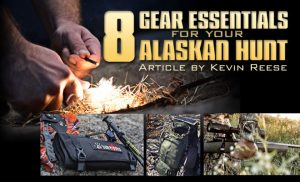8 Gear Essentials
for Your Alaskan Hunt
Story By Kevin Reese
I leveled the barrel of my rifle over the fallen tree trunk and squared-up behind the stock. My heart pounded. Not only could I feel its beat in my chest, but it’s rhythm crept into temples…then my ears. It was deafening as I struggled to slow the rush of adrenaline coursing through my body. Try as I might, I had another fight on my hands. Breathing had become a problem. Hyperventilating is putting things mildly. The more I worked to acquire a crisp field of view and precision sight alignment, the more my scope seemed to fog. Twice, I attempted to wipe the condensation away and twice it was of no help. Even still, I moved forward on my stock, settled into position and took aim.
My heart steadied and I settled down with a couple deep breaths. With a bit of newfound peace, I dropped behind the optics again as the bull began working his way to the trees on the far side of the opening. It was now or never. I breathed heavily, placed the fogged reticle on what I thought was his sweet spot—only now, I wasn’t sure. Like any good hunter, I held on him as best I could and tracked his movement until the fog completely enveloped him; he was gone and my hunt, blown.
Walk on the rocks I stumble on
From close to mid-range wilderness moose hunting to stalking caribou on open ground, ensure your gear is properly designed and suited for your environment. Doing so only leads to an enriched outdoor experience and certainly ups the odds of good memories and a freezer full of meat. Conversely, ill-planning and unsuitable gear can easily leave you fighting for your life in unforgiving circumstances.
My problem became abundantly clear—I was completely ill-prepared. Not only did I blow my hunt, I compromised my well-being. Alan Jackson sang it much better than I’ve ever said: “Walk on the rocks I stumble on.” If I was good for anything on that hunt, I was a remarkable example in a critically important, teachable moment. Don’t make my mistakes.
When selecting the right close-, mid- or long-range optics, backpacks and other necessary gear for the upcoming hunting season, consider these eight pieces of essential gear.
Set your sights on the right optics: Riflescopes and Binoculars
The best path to success is first determining your protective need for those features you’ve heard or read about over and over again—fogproof, dustproof, shockproof, nitrogen-purged, etc.; second, know your environmental needs for your optics—close quarters, mid-range, long-range, open fields, thick wooded areas, high elevations, waterways, salt- or fresh waterways, high or low humidity; and finally, have an idea of what you would like your optics to do to enhance your hunting, shooting and viewing experiences—durability, illuminated reticle, wire or etched reticle, MOA or MIL adjustability, first or second focal plane, zero stop, capped turrets, parallax adjustment, fixed or variable magnification, magnification range, etc. All of those questions need some semblance of answers before making an educated purchase. If it seems like a lot to chew on seasoned shooters and hunters are always open to giving you their advice.
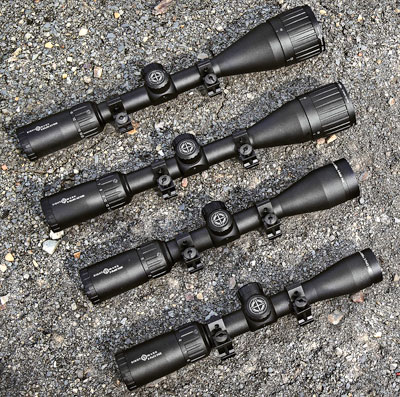
When it comes to fogging, all quality optics should (a vast majority do) deliver the goods when it comes to sealed internals. They are dustproof, fogproof and should also be weather resistant at a minimum—even better if they are waterproof (IP67 or IP68 rated). Nitrogen purging is a key element to keeping moisture, i.e. condensation, fogging, etc., outside the unit. When looking for any optic that may be exposed to moist (humid) or otherwise extreme environments, ensure it is nitrogen purged. Nitrogen purging is simply a process of replacing air with dry nitrogen gas to eliminate moisture.
Additional features such as low dispersion (LD) or extra-low dispersion (ED) are also great and should be sought if such optics fit your budget. The result of LD or ED is greater clarity and color by suppressing or eliminating chromatic aberration; put simply, ensuring colors are converging on the same focal point to deliver a sharper, richer image.
When it comes to expected distances, a key ingredient in picking the right sights, riflescopes, binoculars and other useful optics, consider what your most likely field of view, environmental variables and what expectations are for accuracy or detailed glassing. For close-range, personal-defense and other up-close experiences, reflex sights like Sightmark’s Ultra Shot M-Spec may be a perfect choice. Traditional red-dot and low-powered prism sights might also be a great choice. Tactical riflescopes also serve more than operator purposes and are great for hunting at close- to mid-range. Often, these scopes include illuminated reticles for better lowlight use or improved contrast between the reticle and target. 1-4x might be great out to 300-400 yards while 1-6×24 scopes like the first-focal-plane Sightmark Pinnacle are great even out to 500 or more for experienced shooters.
For mid- to long-range shooting, it’s tough to beat the traditional 3-9×40. For folks that like to take long, precise shots, high-powered scopes like a Pinnacle 5-30×50 first-focal-plane with 1 mil adjustability, illuminated reticle, zero-stop and multi-coated glass just might be the ticket. In the end, determining what distance you’re likely to be comfortable shooting, as well as what distance you’re likely to be shooting in your hunting situations, determines what magnification you should be running. While binoculars and riflescopes are two essential pieces of gear, presenting the ideal optic isn’t as easily done as these other six essentials.
When it comes to binoculars, I prefer 8×32 for bowhunting and closer encounters, 10×42 for bowhunting and rifle hunting in more open areas and glassing mid-range, and 10x or 12×50 for long-range glassing. For long-range scouting, I prefer a 20-60×80 and since I use mil adjustments and a Sightmark Pinnacle 5-30×50 for long-range shooting, the Sightmark Latitude Tactical XD Spotting Scope fitsmy bill perfectly. The LD, ED or XD in glass features relates to lower dispersion levels; in short, this type of glass reduces or eliminates chromatic aberration.
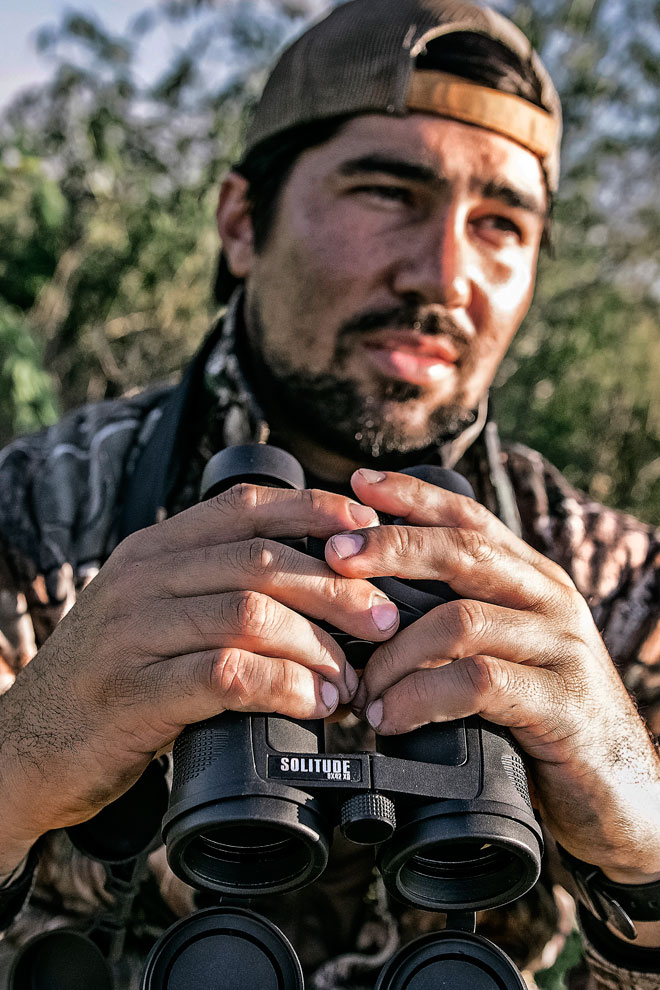
Not all backpacks are equal
The same approach may apply to backpacks but narrowing things down to a day or weekend hunt versus a long stretch far from any grid boils things down to just three types of packs—a waist-pack, day- or weekend pack, and a pack for long off-the-grid adventures. If possible, choose a pack designed to not only carry the other seven essentials (and your other gear), but also carry your rifle or bow when the need arises. A robust waist pack is ideal for light day-hunt where only basic hunting gear is required, along with a few survival items in case the world has other surprises lying in wait.
Day- and weekend packs should also be light, offer plenty of room for those hunting and survival essentials, other desirable gear and maybe even an extra coat or change of clothing. The pack should also be capable of accommodating other items like a tent (for the weekenders), bedroll, rifle or bow, maybe even a hydration pack, depending on expected use. Make sure you load it up and spend some time underneath it. If it’s not comfortable on your back from the beginning, it won’t get that way. Pay attention to any rubbing or hot spots developing while in your “testing” mode.
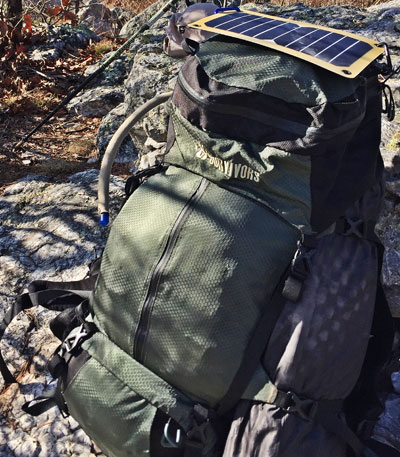
“Always carry a good knife!”
My pop always said, “The most important thing you can carry through life, besides integrity and the Golden Rule, is a good knife, especially outdoors.” From hunting, processing game, ancillary cutting to your most critical survivor tool, most seasoned hunters, anglers, survivalists and outdoor enthusiasts agree your knife is the right answer. Whether you carry your favorite heirloom Case pocket knife, ready-for-anything Bowie knife or something in between like a 12 Survivors BKE knife, carry something!
In addition to a good knife, a good knife set or field-dressing kit is also a great idea! 12 Survivors offers a couple variants of field-dressing knife kits. Not only can knives and field dressing kits be used for their specific purposes, they can be a game-changer if you-know-what hits the fan. And, when you’re off the grid in Alaska, that fan can get hammered repeatedly.
Water filtration
Recently, I spent some quality time with a 12 Survivors Pocket Water Purifier and determined it ranks highly in essential gear. When you’re talking about something compact, ultra-lightweight and designed to sustain life, a water filtration “straw” like the Pocket Water Purifier is a MUST HAVE. Even Alaska lakes, ponds, rivers and creeks can become hotbeds for life-threatening bacteria. Is unfiltered water worth the risk? Uhh, generally not!
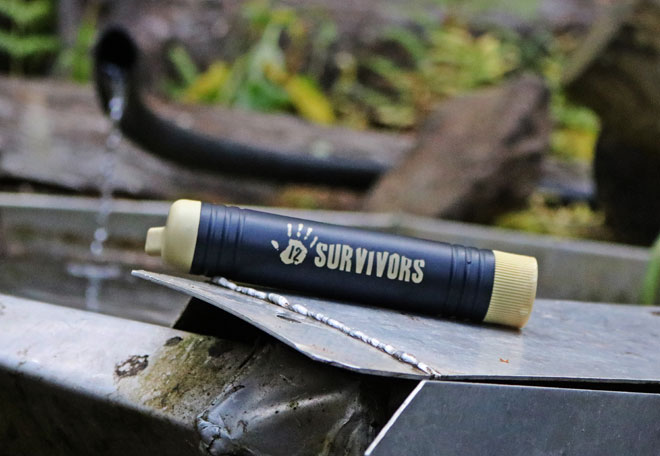
Survival Kits… People depend on you to come home
Years ago, while hunting elk in the Bob Marshall Wilderness in western Montana, I ventured just 300 yards off a logging road down into a large bowl laden in fresh snow and getting deeper by the minute. The area was thick with black timber, save a few bald spots. As I scoured the area for elk sign, the sun began to sink. “Time’s up,” I thought to myself as I stuffed shouldered my rifle to head out. Unfortunately, my exit was immediately and abruptly halted. I did not know which way was out!
I tried following my footsteps but they circled and weaved in every direction; it was a pointless effort. I would have used a compass; however, venturing in only a couple hundred yards, I figured I did not need it. I attempted to follow my steps again but they again were in every direction with many disappearing under new-fallen snow. The temperature at the 9,000-foot elevation was -20 degrees Fahrenheit and it certainly was not going to warm up with nightfall. I was in panic mode as reality set in that I may not survive the night. I was ill-prepared for all night in the weather without a compass, lighter or even a Firestarter. Fortunately, at nightfall, the stars gave me direction. I headed west and came out to the logging road a couple hours later. I walked a couple miles back to camp where some had already set off looking for me. Lesson learned, I never go anywhere without a compass, even if I have a cell phone and electronic GPS; batteries die, compasses do not.
Since then, I’ve hunted a lot of remote areas and have expanded beyond a compass attached to my coat to a true survival kit. My kit is compact and weighs less than a half-pound, nevertheless, it contains an additional compact compass, folded map of the area I’m hunting, lighter, Firestarter in case the lighter fails, paracord, fishing line and hook, and a mirror. My contents are in a nylon pouch but also placed in a sealable freezer bag.
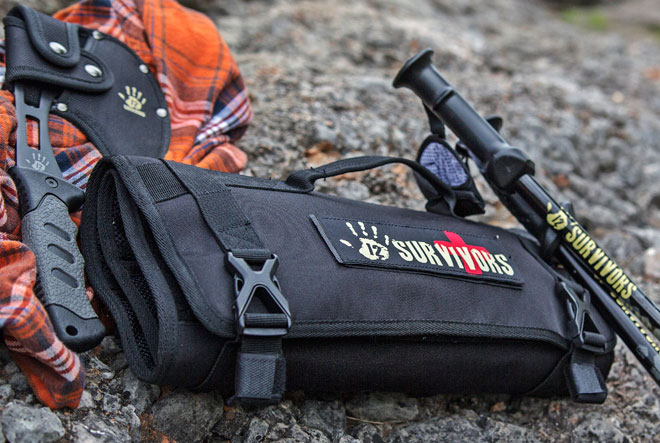
First-Aid Kits… And a little MacGyver attitude
Like the survival kit, my first aid kit is compact, lightweight and stored the same way, in a pouch, then in a sealable bag. My first aid kit includes an array of traditional bandages, scissors, tourniquet and sling material, Super Glue (yes, it’s true—to each their own), medical tape, antibiotic ointment, sanitizer, aspirin, ibuprofen, gauze, wrap and a small sewing kit in case I need to jump into MacGyver mode.
A tarp makes any place home, right?
There’s not a whole lot to add here. Using a compact, lightweight tarp can make dragging your animal (or meat) out, especially if you’re friends aren’t into helping you carry or drag quarters. It also doubles as lean-to shelter, using that paracord in your survival kit, to help you get out of the elements. During my time in the Marine Corps, each of us received only half of a pop-tent (we called it a hooch). It was a lean-to or with your buddy, it was a tent. Usually, those decisions were made for us.
Your closest friend may become a flashlight
Carry a good flashlight! Don’t depend on the light from your cell phone…or some medieval torch to make life easier out there. It gets awfully dark out there and one slip can be a game-changer. Carrying a rugged, reliable flashlight (and extra batteries) makes blood-tracking easier, processing your game after dark much faster, the trek back from your hunt safer and is likely to be one of your closest friends if something bad happens mid-adventure. I cannot over-emphasize the importance of good light! My personal favorite is the compact, IP67 waterproof, 600 lumen Sightmark SS600 Flashlight. The SS600 features three modes, bright (600 lumens), low (100 lumens) and strobe, great for signaling.
BONUS ESSENTIAL: CARRY YOUR SMARTPHONE!
More than having a plan and ensuring people know precisely where you are hunting, a cell phone is an essential item nowadays. Smartphones are incredibly powerful and have saved many lives on many occasions in recent years. With onboard GPS, mapping and navigation, as well as an additional light source, weather apps, 911 and traditional calling access, text capabilities and even camera functions, phones also have become something of a survival kit; of course, if looking for a signal may have you pulling your hair out. 12 Survivors even offers one-, two- and three-panel solar device charging stations more than compact enough to fit in your pack.
Useful Links:

